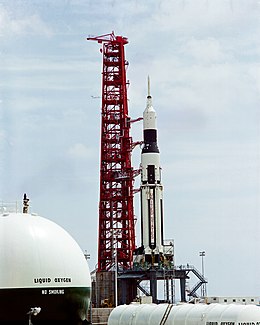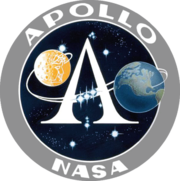

This article's lead section may be too short to adequately summarize the key points. Please consider expanding the lead to provide an accessible overview of all important aspects of the article. (December 2010)
|

A-101 (SA-6)
| |
| Mission type | Test flight |
|---|---|
| Operator | NASA |
| COSPAR ID | 1964-025A |
| SATCAT no. | 800 |
| Mission duration | ~3 days, 8 hours |
| Orbits completed | 54 |
| Spacecraft properties | |
| Spacecraft | Apollo BP-13 |
| Launch mass | 7,700 kilograms (17,000 lb) |
| Start of mission | |
| Launch date | May 28, 1964, 17:07:00 (1964-05-28UTC17:07Z) UTC |
| Rocket | Saturn I SA-6 |
| Launch site | Cape Canaveral LC-37B |
| End of mission | |
| Decay date | June 1, 1964 (1964-07) |
| Orbital parameters | |
| Reference system | Geocentric |
| Regime | Low Earth |
| Perigee altitude | 178 kilometers (96 nmi) |
| Apogee altitude | 199 kilometers (107 nmi) |
| Inclination | 31.7 degrees |
| Period | 88.26 minutes |
| Epoch | 30 May 1964[1] |

Project Apollo
Unmanned test flights
A-102 → | |
A-101[2] was the first boilerplate test flight of the Apollo spacecraft, which was launched using SA-6,[3] the sixth Saturn I rocket to fly. The flight took place in 1964.
The first five launches of the Saturn I had carried Jupiter-C nosecone that were a proven design allowing engineers to focus on the rocket. However, in order to get to the Moon, it had to be shown that the rocket could actually launch the Apollo spacecraft shape. Therefore, on A-101 the rocket carried a boilerplate spacecraft and a dummy Launch Escape System (LES). The Boilerplate BP-13 duplicated the size, weight, shape, and center of gravity of a manned Apollo command module.[citation needed] A flight-weight command module weighed around 12,000 pounds (5,400 kg); the boilerplate command/service module combination weighted 17,000 pounds (7,700 kg).[3]
This allowed it to be instrumented with 116 measuring devices so that engineers could see the strain, pressure, and acceleration experienced by the spacecraft, which they hoped would confirm their calculations.
It took three attempts to get the rocket off the pad. The first launch attempt was scrubbed after the liquid oxygen damaged a wire mesh screen during a test, causing fuel contamination. The second attempt was scrubbed after the rocket's guidance system overheated when a compressor failed in the air conditioning.
It finally lifted off on May 28, 1964, from LC-37B. There had been several delays during the count as liquid oxygen vapors obscured an optical window in the SA-6's instrument unit, so that a ground-based theodolite could not see it. This theodolite was needed for launch to proceed. Engineers removed this requirement, which was not critical, from the computer, allowing the launch to proceed.
The ascent was normal up to 116.9 seconds after launch. At that point, engine number eight shut off early. This was not planned as on SA-4 but, pleasingly for engineers, the rocket compensated perfectly and burned the first stage for 2.7 more seconds than planned. The first stage separated and the second stage ignited. Ten seconds later, the LES was jettisoned as planned (any explosion would not be so catastrophic as to need its ability to pull the spacecraft away at high speed). Also jettisoned from the first stage were eight film cameras that observed separation of the stages.
The second stage cut off at 624.5 seconds after launch (1.26 seconds earlier than predicted), with the stage and boilerplate in a 182 kilometers (113 mi) by 227 kilometers (141 mi) orbit. It continued to transmit data for four orbits when the batteries failed. Both stayed in orbit for 54 orbits, re-entering the atmosphere east of Canton Island in the Pacific Ocean on June 1.
Engineers were quick to find the cause of the failure of engine number eight. The teeth on one of the gears in the turbopump were stripped off. This did not cause any delays in the next launches as engineers had already decided that the gear design was inferior and were planning to change it for the next launch. This was the only problem encountered with an H-1 engine during a flight.
![]() This article incorporates public domain material from websites or documents of the National Aeronautics and Space Administration.
This article incorporates public domain material from websites or documents of the National Aeronautics and Space Administration.
|
| |||||||||||
|---|---|---|---|---|---|---|---|---|---|---|---|
| |||||||||||
| Launch complexes |
| ||||||||||
| Ground facilities |
| ||||||||||
| Launch vehicles |
| ||||||||||
| Spacecraft and rover |
| ||||||||||
| Flights |
| ||||||||||
| Apollo 8 specific |
| ||||||||||
| Apollo 11 specific |
| ||||||||||
| Apollo 12 specific |
| ||||||||||
| Apollo 13 specific |
| ||||||||||
| Apollo 14 specific |
| ||||||||||
| Apollo 15 specific |
| ||||||||||
| Apollo 16 specific |
| ||||||||||
| Apollo 17 specific |
| ||||||||||
| Post-Apollo capsule use |
| ||||||||||
| Related |
| ||||||||||
| |||||||||||